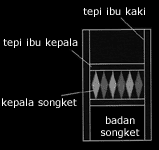 |
Tuck away in the
southern west fringe of South China Sea, in a humble
village of Chendering, Kuala Terengganu, Malaysia,
housewives and young girls weave songket in their
backyard as a tradition. This is the home where the
finest woven songket can be found, along with the
gentle ocean breeze, coconut trees and rustic charm
of village life.
In this part of the world, the tropical
climate and the fertile soil blessed the native with
an abundance of plants. Long have the Malay exploited
the medicinal properties of these plants, from its
flowers, roots, leaves, fruits, bark and seeds. In
appreciation, they were immortalised into arts and
crafts.
Various sweet-smelling plants, food, people, animals,
inanimate objects, natural landscape patterns and
motifs - sometimes abstract, in other times vividly
captured - are the primary sources of inspiration.
Motifs
& Patterns | Design
Structure


Songket, in the hand of Bibah, soon embark on a journey
of modernisation. The traditional motifs such as pucuk
rebung (bamboo shoot) were unconventionally intepreted
in a sophisticated dimension. New patterns were conceived
and one of such instance is the transformation of
the simple isosceles triangles of pucuk rebung into
a complex lace-like patterns - which appears surreal
yet distinctive to the keen eyes.

|
|